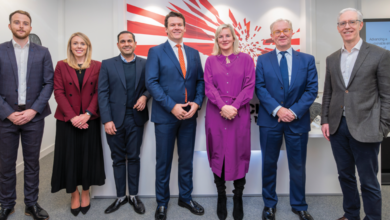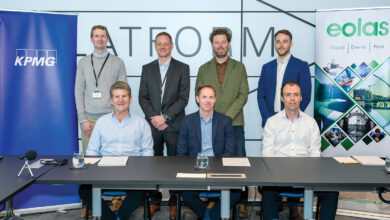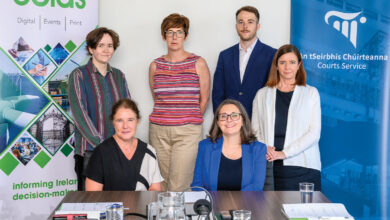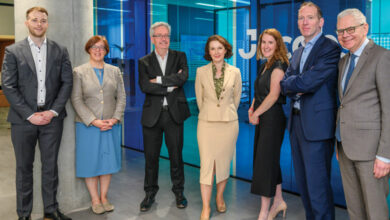Security of supply: Powering Ireland’s infrastructure plans
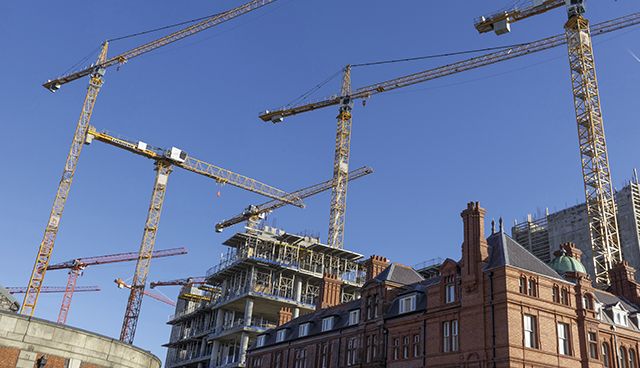
EY Ireland hosted a virtual round table discussion with experts from across several commercial and non-commercial state bodies, and major national infrastructure providers, to explore security of supply in supporting and facilitating Ireland’s infrastructure ambitions.
What role will your organisation play in meeting Ireland’s national infrastructural needs?
Ferga Kane
EY is here to support the delivery of Ireland’s infrastructure plans as well as the Climate Action Plan 2021. Each part of our business is involved in supporting infrastructure delivery, including work in both the public and private sector on infrastructure development. For example, we are currently supporting the Department of the Environment, Climate and Communications by providing oversight on the rollout of the National Broadband Plan and we are supporting ESB in its smart metering programme. We are also supporting the NTA and TII on several transport projects including BusConnects and MetroLink. More broadly, there is our work supporting Irish businesses who are crucial to the successful delivery of infrastructure projects. We combine our local expertise and knowledge with insights from specialists across our global network, ensuring we consistently deliver best practice and the greatest success for the projects we are involved in.
Eamon Gallen
Irish Water is an enabler of growth and development, particularly in housing. Last year, Irish Water approved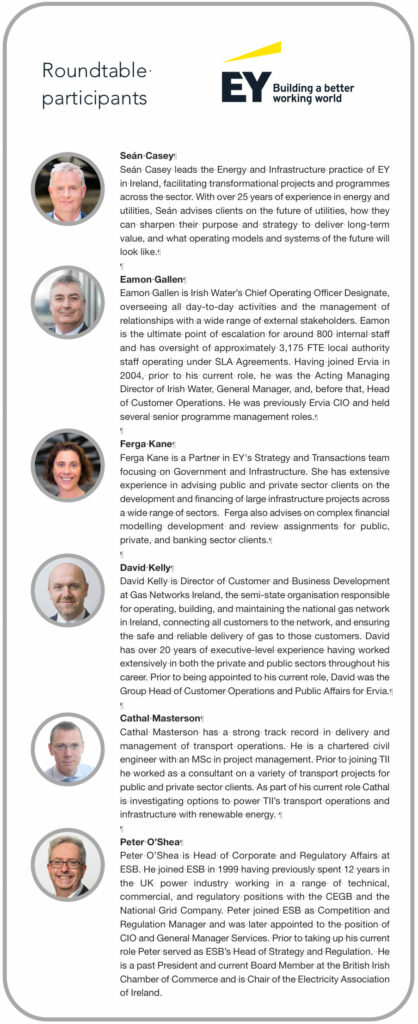 34,579 units. From our own perspective, without Irish Water, there is no housing, there is no industry, and there is no FDI because you cannot operate without utilities. One of the things that we have undertaken is publishing capacity registers. These are published on our website, water.ie, and issued to all local authorities to illustrate where we have capacity and where we do not.
34,579 units. From our own perspective, without Irish Water, there is no housing, there is no industry, and there is no FDI because you cannot operate without utilities. One of the things that we have undertaken is publishing capacity registers. These are published on our website, water.ie, and issued to all local authorities to illustrate where we have capacity and where we do not.
David Kelly
Gas Networks Ireland is a key player in Ireland’s infrastructure. The €2.7 billion national gas network is publicly owned, provides 50 per cent of Ireland’s electricity and 40 per cent of our heating. Project Ireland 2040 envisages an additional one million people living in the State and the idea that there would be insufficient electricity or energy to support that growth is anathema. Mirroring the Government’s agenda, we want to increase renewable electricity by increasing renewable gas to generate it, without any significant cost to the taxpayer or disruption to energy supply. If Ireland can get to 80 per cent renewable electricity by 2030, that would be fantastic. However, the gas network will be vital to not only reliably meet the remaining 20 per cent but also to provide flexible back up for renewables at times when the wind is not blowing, and the sun is not shining. We also need to remember that electricity only meets around one-third of Ireland’s total energy. In the longer term, gas, particularly the adoption of biomethane and hydrogen, is key. Our role is to provide that enabling infrastructure, to ensure that it is maintained and future ready.
Peter O’Shea
ESB is investing approximately €1 billion in capital expenditure every year. We are one of the most significant providers of infrastructure in Ireland. Our business is closely aligned with delivery of the Climate Action Plan and, ultimately, the decarbonisation of society between 2040 and 2050. Electricity is the vector for decarbonisation. We are investing in renewables, both onshore and offshore, and transmission and distribution capability to ensure that we can take those new sources of electricity, which are more dispersed, and deliver them to a very different type of customer in years to come. On the supply side, we want to ensure customers have the toolkits to engage fully with the transition and the market. There is a need for a bottom-up approach where we are engaging with customers and building them into the transition as well as a top-down approach.
Cathal Masterson
For TII, there are three main areas of focus over the next decade. Firstly, maintaining and investing in the national road network, particularly the high-capacity interurban routes which connect the regions and industry to both national and international markets, via our ports and airports. The second is public transport infrastructure both in terms of upgrading the road network to facilitate increased bus usage, alongside the operation and expansion of light rail networks in Dublin and Cork, and delivery of MetroLink. The third area is delivery of new national cycling infrastructure and greenways, which TII is keen to develop as a multiannual programme over the next decade.
“We need to carefully manage the transition and not create security of supply issues which are a real risk to our economy.”
— Sean Casey
How will investment in regulated network infrastructure contribute to a safe, secure, sustainable, and competitive long-term energy future for Ireland?
Seán Casey
Currently, Ireland is investing heavily in energy infrastructure firstly, to enable and facilitate a net zero system and secondly, to cater for a large increase in economic development and demand. The regulated industries responsible for delivering the wide range of infrastructure have a good track record of delivery this infrastructure but there are notable risks for many of these programmes. Alongside delivery risks, there are two core challenges. Firstly, building infrastructure and connecting energy resources for a new energy world takes time. We need to carefully manage the transition and not create security of supply issues which are a real risk to our economy and secondly, we must ensure that we are getting value from this investment.
Peter O’Shea
Looking beyond 2030, hydrogen will be a crucial tool to meet our ‘last mile’ challenge of decarbonising electricity, as well as hard to abate sectors. Hydrogen’s versatility presents major opportunities. However, it is not naturally forming, and there are challenges relating to the various storage options and establishing the best use case for efficiency, all in a way that meets the requirements of the energy trilemma.
David Kelly
The role of the regulator is critical. A prime example is the recent call by the CRU for 2GW of investment in gas-fired generation to meet security of supply issues, which has also led to new government policy. Regulation will be critical in the advent of the biomethane and hydrogen sectors to ensure that the right standards and the right regimes are in place to enable a safe and smart environment to work in. We encourage and are actively working with the regulator and other stakeholders to establish these indigenous renewable gas sectors as quickly as possible, and it is an area we would like to see more focus on.
“In Ireland, over recent years, many good plans have been developed. Now, we need to move from the planning phase into delivery.”
— Peter O’Shea
Cathal Masterson
In terms of energy consumption, the transport sector has become much more aware of the energy it consumes to power our infrastructure and services. This has been encouraged by the International Transport Forum’s recommendation for the transport sector to collaborate more closely with the energy sector. For instance, we have been exploring options to procure green energy to power light rail and MetroLink services. Similarly, there is a need to examine national fuelling infrastructure for alternative fuels, particularly for the freight sector. It is an area that will need stronger collaboration from multiple actors.
Eamon Gallen
Regulated entities are often perceived as slow to innovate and slow to deliver but it is important to remember the vital strategic role they play in planning and access to funding. One of our investment categories for next year is in growth; building infrastructure to cater for demand. In the absence of a ‘customer’, regulated entities, funded from the public purse, recognise the country’s longer-term requirements. Additionally, as one of the largest consumers of electricity, we recognise that we have a significant carbon footprint. Therefore, advances in hydrogen technology are critical for Irish Water’s ambitious decarbonisation goals.
To what extent will delivery of the new National Development Plan (NDP) be hampered by supply side capacity constraints?
Cathal Masterson
The first thing that springs to mind is funding, resourcing, and skillsets. You obviously cannot invest in something new without the right mix of resources. However, there are other legal, institutional, and sectoral constraints on the supply side which we must deal with as public agencies and there is also a need to be better organised by having a regular project pipeline to counter the inefficiencies of stop-start nature infrastructure investments.
David Kelly
The supply side constraints are real. The housing crisis is one of Ireland’s foremost public concerns and that places demands on the construction sector. Representative bodies for construction have highlighted challenges relating to labour, materials, transport, and Brexit. We must get smarter about how we do things and how we collaborate with other entities. Our targets should be ambitious, but they must be realistic. We need to factor in what is achievable and affordable when we are mapping out our policy goals. It is also important that we address the planning process. While not necessarily a supply side constraint, it is a very real challenge when you factor in cost and the elongated project completion times. If we are collaborating on the ground, we should also collaborate on the planning policy agenda.
“Regulated entities are often perceived as slow to innovate and slow to deliver but it is important to remember the vital strategic role they play in planning and access to funding.”
— Eamon Gallen
Peter O’Shea
When I look at supply side, I consider four areas. Firstly, funding, I do not see that as the constraint when you see the commitments that emerged from COP26. Secondly, construction materials, they may well be tight in some areas, including housing for example. Of the two remaining challenges, the first is skills capacity, particularly craft skills, in the context of the national retrofit targets. The second, is policy frameworks. While the policies are good, the frameworks that make them happen need some attention, particularly on the planning side.
Eamon Gallen
We are finding it difficult to compete for the same pool of resources with regards to the supply chain. We must grow a water-specific supply chain, which has its own challenges. To develop resources to buy or lease plant, companies must have consistency of work coming towards them. That is difficult in an open and competitive procurement process. We have trawled Europe and the UK to attract talent in on smaller schemes to build up water expertise, which is also challenging.
Seán Casey
In terms of supply, there are undoubtedly challenges, not only shortages but also pricing challenges. The price of copper has increased by around 8 per cent over the last 12 months, while lumber has gone up 60 per cent since 2019. Clients are talking about these issues in sectors where we have not heard them before. As countries undertake countercyclical green capital recoveries, we cannot be complacent. We must address skill shortages and supply chain constraints.
How can government and industry collaborate to best support the delivery of the new NDP objectives?
David Kelly
The new NDP is very welcome. Gas Networks Ireland works very closely with IDA Ireland and there is no doubt that there have been concerns expressed by IDA clients around challenges such as energy security. We welcome the policy statement relating to the additional gas infrastructure to provide back up in the event of intermittency and IDA clients welcome that certainty. Those clients also want to see a roadmap to a decarbonised energy future. We have certainly observed significant interest in renewable gas, particularly biomethane from the agri-food sector. We will be actively working with government around policy support for biomethane and hydrogen and to ensure an enhanced dialogue over the coming months and years.
Ferga Kane
The most important pillar of collaboration between government and industry is communication. Providing the market with transparency on the pipeline of projects, their timescale, size, expected structure and contract type etcetera, enables the private sector to better position itself in terms of capacity. Transparency also helps attract talent from other markets. Market participants want certainty and are more willing to make an investment in capacity if they have clear line of sight on timing of a committed pipeline. While the new NDP is a fantastic framework that provides an overview of the areas of investment, clarity on the details of the pipeline of projects is required. Providing this information in relation to the Climate Action Plan 2021 is crucial also.
“Following the Covid-19 pandemic, priorities and preferences are changing, including where people want to live and how they want to work. Climate action and sustainability is central to that.”
— Fergal Kane
Eamon Gallen
Planning legislation must be urgently examined. It is a huge burden for Irish Water. The process must be fast-tracked, it must be reasonable, and it requires expert examination, particularly for larger strategic projects. If we keep going in this direction, the taxpayer will continue to lose out. Similarly, governance needs to speed up. The Public Spending Code is a great tool but if it adds another layer of complexity and an additional six months onto projects, that will cost us all more time and money. On a positive note, we can and already do collaborate on key elements of infrastructure delivery, including health and safety.
“Project Ireland 2040 envisages an additional one million people living in the State and the idea that there would be insufficient electricity or energy to support that growth is anathema.”
— David Kelly
Peter O’Shea
When I think of collaboration, I think of trust. I also think of an orchestra; one of the most collaborative art forms is orchestral music. What makes an orchestra collaborate well? Firstly, it has a very clear plan in the music sheet. Secondly, it has a proficient conductor who understands that the total output is dependent on each section of the orchestra playing to the best of its ability, and thirdly, it has talented musicians. In Ireland, over recent years, many good plans have been developed. Now, we need to move from the planning phase into delivery. This year, ESB announced Green Atlantic at Moneypoint, a major renewables programme which includes green hydrogen production. However, Ireland does not currently have a hydrogen strategy. As such, we must take the overarching plans and break them into their constituent parts so that each section of the orchestra can play to its strengths, building trust across the system in a manner which ultimately gets the best outcome for the people we are here to serve: our customers.
Cathal Masterson
I think we should be mindful that this is not a normal National Development Plan in that it was published in tandem with the Climate Action Plan 2021, and we all must play our part in transitioning to a more sustainable economy and society. If we are going to grasp the nettle on decarbonising the economy or embedding circular economy principles in our construction programmes, we are going to need to collaborate more. Arguably we should develop an holistic national infrastructure portfolio, rather than continue to invest on a project-by-project perspective. Where there are real delivery obstacles imposing costs and delays to infrastructure investment, we should have a proper discussion on solutions at a national level.
Overall, what is your organisation’s perspective on public infrastructure requirements and investment decisions over the next decade?
Peter O’Shea
Our focus is on how we play our part in delivering the Climate Action Plan. That comes down to generation investment in renewables in offshore and onshore; such as Green Atlantic at Moneypoint, investment in Networks to connect new sources of electricity generation and delivery to customers. These customers are becoming more efficient in their use by retrofitting their homes and using electricity differently with heat pumps and electric vehicles. As I said earlier, we need to get change from the bottom up, if we do not inspire and motivate people to make the change themselves, we will not get the full distance.
David Kelly
Sustainability is a strategic pillar at Gas Networks Ireland and any investment decision we make has sustainability at its core. Our vision is to transition into a network that carries renewable gases. It is going to take time but, it is important to articulate this vision now. Ireland’s first wind farm was built in 1992 and it has taken 20 years to get as far as we have with renewable electricity. New technologies take time to roll out. In 2020, we invested €112 million into Ireland’s gas network and as we transition to a cleaner energy future, we will continue to invest in bringing renewable gases on to the network. These carbon neutral gases will come initially through our interconnectors to the UK. The UK is a few years ahead of us and will have hydrogen on its gas network in the next four or five years and we need to be ready for that.
“If we are going to grasp the nettle on decarbonising the economy or embedding circular economy principles in our construction programmes, we are going to need to collaborate more.”
— Cathal Masterson
Cathal Masterson
The framework for evaluating and making investment decisions for national infrastructure is changing and will be completely overhauled by the end of this decade. The fundamental drivers for transport infrastructure are also changing and for instance aside from a handful of schemes that have been in the planning pipeline for a long time, we will be focused on maintaining the network as opposed to providing additional road capacity. TII will be focused on investing in public transport and active travel infrastructure to support policies around compact growth and sustainable land use. We will also invest in technologies to support sustainable mobility solutions.
Eamon Gallen
On a macro level, we have not seen the last of Brexit yet. Covid has camouflaged some of that, but we still need establish its full implications, from movement of the workforce to economic impacts. If there is increasing economic activity, then we will need more utilities and vice versa. From an Irish Water perspective, our initial focus was on maintaining assets. We are now pivoting to facilitating growth and long-term planning.
Ferga Kane
Following the Covid-19 pandemic, priorities and preferences are changing, including where people want to live and how they want to work. Climate action and sustainability is central to that, and everyone has a role to play to help achieve our national targets. This continuing shift towards more sustainable living will drive changes in behaviours. While we have clear and overarching infrastructure plans, we must continuously assess and consider how that infrastructure is going to be used and where it must be located. That takes real ongoing commitment, and it is critical that all future governments commit and continue with plans for infrastructure delivery. Without that commitment and consistency, it is extremely difficult to deliver these long-term infrastructure projects.



